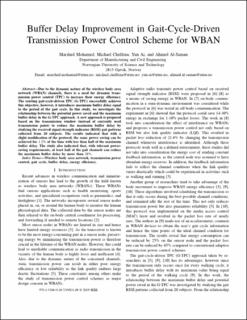| dc.contributor.author | Mohamed, Marshed Kassim | |
| dc.contributor.author | Cheffena, Michael | |
| dc.contributor.author | Ai, Yun | |
| dc.contributor.author | Al-Samman, Ahmed | |
| dc.date.accessioned | 2020-10-29T09:46:28Z | |
| dc.date.available | 2020-10-29T09:46:28Z | |
| dc.date.created | 2020-10-28T09:33:17Z | |
| dc.date.issued | 2020 | |
| dc.identifier.citation | IEEE International Symposium on Personal, Indoor, and Mobile Radio Communications workshops. 2020, . | en_US |
| dc.identifier.issn | 2166-9570 | |
| dc.identifier.uri | https://hdl.handle.net/11250/2685637 | |
| dc.description.abstract | Due to the dynamic nature of the wireless body area network (WBAN) channels, there is a need for dynamic transmission power control (TPC) to increase their energy efficiency. The existing gait-cycle-driven TPC (G-TPC) successfully achieves this objective, however, it introduces maximum buffer delay equal to the period of the gait cycle. In this study, we investigate the relationship between the potential power saved and the maximum buffer delay in the G-TPC approach. A new approach is proposed based on the transmission window (instead of currently used transmission point) to reduce the maximum buffer delay by studying the received signal strength indicator (RSSI) gait patterns collected from 20 subjects. The results indicated that with a slight modification of the protocol, the same power saving can be achieved for 1.2% of the time with less than half of the maximum buffer delay. The study also indicated that, with tolerant power-saving requirements, at least half of the gait channels can reduce the maximum buffer delay by more than 38%. | en_US |
| dc.language.iso | eng | en_US |
| dc.publisher | IEEE | en_US |
| dc.title | Buffer Delay Improvement in Gait-Cycle-Driven Transmission Power Control Scheme for WBAN | en_US |
| dc.type | Peer reviewed | en_US |
| dc.type | Journal article | en_US |
| dc.description.version | acceptedVersion | en_US |
| dc.subject.nsi | VDP::Telekommunikasjon: 552 | en_US |
| dc.subject.nsi | VDP::Telecommunication: 552 | en_US |
| dc.subject.nsi | VDP::Telekommunikasjon: 552 | en_US |
| dc.subject.nsi | VDP::Telecommunication: 552 | en_US |
| dc.source.pagenumber | 4 | en_US |
| dc.source.journal | IEEE International Symposium on Personal, Indoor, and Mobile Radio Communications workshops | en_US |
| dc.identifier.doi | 10.1109/PIMRC48278.2020.9217071 | |
| dc.identifier.cristin | 1842794 | |
| dc.description.localcode | © 2020 IEEE. Personal use of this material is permitted. Permission from IEEE must be obtained for all other uses, in any current or future media, including reprinting/republishing this material for advertising or promotional purposes, creating new collective works, for resale or redistribution to servers or lists, or reuse of any copyrighted component of this work in other works. | en_US |
| cristin.ispublished | true | |
| cristin.fulltext | postprint | |
| cristin.qualitycode | 1 | |
